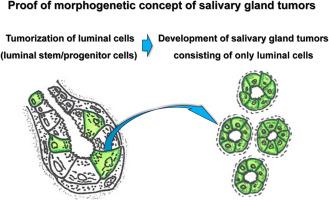PLAG1 overexpression in salivary gland duct-acinar units results in epithelial tumors with acinar-like features: Tumorization of luminal stem/progenitor cells may result in the development of salivary gland tumors consisting of only luminal cells
IF 2.6
Q1 DENTISTRY, ORAL SURGERY & MEDICINE
引用次数: 0
Abstract
Objectives
Details about salivary gland tumor histogenesis remain unknown. Here, we established a newly generated murine salivary gland tumor model that could overexpress pleomorphic adenoma gene 1 (PLAG1) and attempted to clarify the events that occur during the early phase of salivary gland tumor histogenesis.
Methods
Salivary gland tumors were generated using murine models (Sox9IRES-CreERT2; ROSA26-PLAG1). Lineage tracing of Sox9-expressing cells was performed using Sox9IRES-CreERT2; ROSA26-tdTomato mice, which were generated by crossing Sox9CreERT2/- and ROSA26-tdTomato mice (expressing the tdTomato fluorescent protein). Organ-cultured embryonic salivary glands from the murine model were morphologically analyzed, and mRNA sequencing was conducted two days after tumor induction for gene enrichment and functional annotation analysis.
Results
Salivary gland tumors exhibited epithelial features with acinar-like structures because of gene rearrangements in the luminal cells. Structural disturbances in the duct-acinar unit of the salivary gland were observed and cancer-related pathways were enriched among the differentially upregulated genes in the early phase of tumor induction in an organ-cultured embryonic salivary gland tumor model.
Conclusions
The newly generated murine salivary gland tumor model may show that the tumorization of luminal stem/progenitor cells can result in the development of salivary gland tumors comprising only luminal cells.

PLAG1 在唾液腺导管-针状单元中的过表达会导致具有针状特征的上皮肿瘤:管腔干细胞/祖细胞的肿瘤化可能导致仅由管腔细胞组成的唾液腺肿瘤的发生。
目的:唾液腺肿瘤组织发生的细节仍不清楚。在此,我们建立了一种新生成的可过表达多形性腺瘤基因 1(PLAG1)的小鼠涎腺肿瘤模型,并试图阐明涎腺肿瘤组织发生早期阶段发生的事件:方法:利用小鼠模型(Sox9IRES-CreERT2;ROSA26-PLAG1)生成唾液腺肿瘤。利用Sox9IRES-CreERT2; ROSA26-tdTomato小鼠进行Sox9表达细胞的系谱追踪,该小鼠是通过杂交Sox9CreERT2/-和ROSA26-tdTomato小鼠(表达tdTomato荧光蛋白)产生的。对小鼠模型的器官培养胚胎唾液腺进行了形态学分析,并在肿瘤诱导两天后进行了 mRNA 测序,以进行基因富集和功能注释分析:结果:由于管腔细胞中的基因重排,唾液腺肿瘤表现出具有类针状结构的上皮特征。在器官培养的胚胎唾液腺肿瘤模型中,观察到唾液腺导管-针状单元的结构紊乱,肿瘤诱导早期的差异上调基因中富集了与癌症相关的通路:结论:新建立的小鼠涎腺肿瘤模型表明,管腔干细胞/祖细胞肿瘤化可导致仅由管腔细胞组成的涎腺肿瘤的发生。
本文章由计算机程序翻译,如有差异,请以英文原文为准。
求助全文
约1分钟内获得全文
求助全文
来源期刊

Journal of Oral Biosciences
DENTISTRY, ORAL SURGERY & MEDICINE-
CiteScore
4.40
自引率
12.50%
发文量
57
审稿时长
37 days
 求助内容:
求助内容: 应助结果提醒方式:
应助结果提醒方式:


